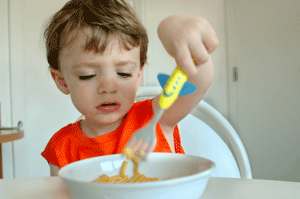
Unfortunately, some parents and caregivers become discouraged and frustrated when their toddler seems to concentrate more on exploring food than eating it. This behavior reflects the emerging curiosity and independence associated with early childhood and is normal. Parents and caregivers can foster this newly found, and often assertively expressed, independence while still ensuring adequate nutrition by offering a well-balanced selection of foods and allowing children to choose the types and amounts of foods they want to eat. Parents and caregivers need to understand that recognizing the child’s signals of hunger and fullness supports the child’s innate ability to self-regulate energy intake and portion size. They also need to understand that a child does not have an innate ability to select only appropriate foods. Food choice remains the responsibility of the caregiver.
Mealtime provides an opportunity for wonderful parent-child interactions. These opportunities exist for the young toddler, who may be fed before the family meal, as well as for the older toddler and preschooler, who may participate in the family routine and sit at the table for a short time. Finger foods should be encouraged because they foster competence, mastery, and self-esteem. Even when the parent or caregiver is doing the feeding, the child also should be given a spoon. The 12- to 15-month-old toddler should be encouraged to use a spoon. When the child is finished eating, she should be allowed to leave the table and be placed where she can be supervised until the adults have finished their meal.
Here is the bottom line and things you can do:
- Picky eating is a VERY COMMON problem and growth is rarely affected because of it. If you are concerned that your child’s growth is adversely affected by his or her picky eating habits please set up an appointment so that we can measure your child and go over their growth charts together.
- A calm and pleasant mealtime atmosphere can improve willingness to try new food. Avoid mealtime battles. Avoid discussing how much food the child is eating and bargaining for “one more bite.” Focus on another topic of conversation. Food tastes better in a positive social context.
- Social cues: If child has the opportunity to eat meals with other children (such as in preschool), this may be an opportunity to expand the child’s repertoire of foods. They are much more willing to try that broccoli once they see their classmate eating it too.
- Positive reinforcement: Provide verbal praise for trying a new food. Parents should not provide material or food rewards for eating (giving a dessert for eating a vegetable), and should never punish a child for refusal to try new foods.
- Repeated exposure: Increased familiarity results in increased liking. If you wish the child to accept vegetables, chose a generally mild, palatable vegetable to be served at dinner repeatedly.
- Forced exposure: The “try one bite” rule has been shown to result in increased willingness to try new foods over time. However, if the child has a difficult temperament and taking a bite is disruptive to meal time, this method should not be used.
- Combining food: Combining non-preferred food (vegetable) with a preferred food (ranch dressing) may be helpful – even in seemingly illogical combinations. If a child wants to dip carrot sticks in soup, and this increases his willingness to eat carrots, this should be accepted as oppose to disallowing it because it is “bad manners.”
- Never have the television on at mealtimes, even to use as a distraction to get the child to eat.
- For food ideas that are appropriate for your child’s age and weight, please visit www.choosemyplate.gov.
Here is a common dinner time scenario. The family has worked hard to prepare dinner and the playful toddler refuses to eat dinner despite parental pressure and using all the above tips. You eventually let the child leave the table. Usually half an hour later you’ll see her back asking; “mommy, I am a little hungry, can I have a cookie?” Of course the answer should be: “no, your dinner is still there, why don’t you finish your dinner and then if you are still hungry we will think of something.” Your astute toddler response usually will be: “no, never mind…. I am OK for now.” Then one hour later, now before bedtime, you will see her again coming to you: “Mommy, I am thirsty, can I have some juice before I brush my teeth?” and of course your answer should be: “here is some water sweetheart if you are thirsty. If you are still hungry your dinner is still siting at the table!” This is when you will here some extra complain/winning and the obvious contemplation for any caring parent or grandparent is “should I let her go to bed hungry, or should I let her have that piece of cookie so at least ‘she’s got something in her stomach.’” And the correct course of action is to let her go to bed hungry!! Do not feed into this behavior. Realize that the older the child is the more difficult it is to change these habits. So if you think it is difficult now, this is actually as easy as it gets. The older we get as human beings, the more difficult it is to change our habits.
Again, picky eating is a very common behavior for children between 2-6 years of age. We will be happy to discuss any other aspect of this regularly encountered problem in the office.
Adapted from:
- Bright Futures: Guidelines for Health Supervision of Infants, Children, and Adolescents, Third Edition. From the American Academy of Pediatrics.
- Developmental and Behavioral Pediatrics. 2nd Edition. Parker et al. Lippincott Williams & Wilkins 2005.
